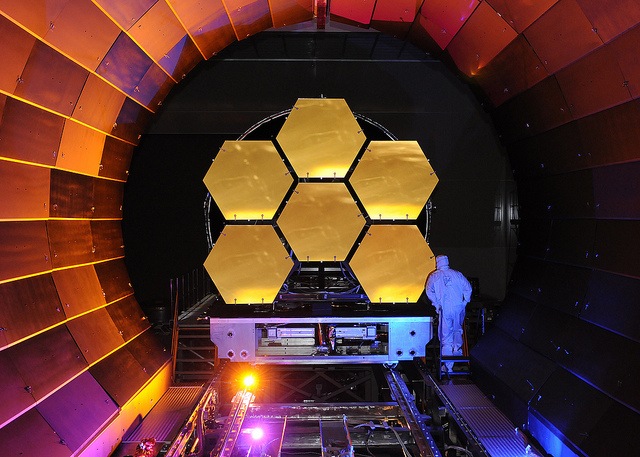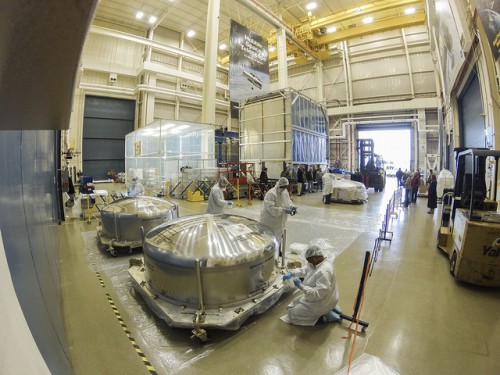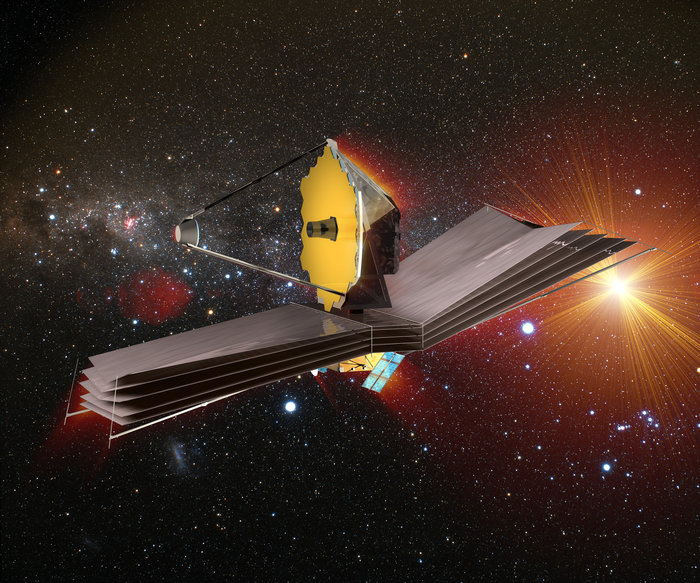
In what constitutes important and exciting news for space science and astrophysics, the final segments of the primary mirror for the James Webb Space Telescope (JWST) have been delivered to NASA’s Goddard Space Flight Center in Greenbelt, Md.
Often touted as the successor to Hubble, the James Webb Space Telescope, a joint NASA/ESA/Canadian Space Agency effort, is one of the most ambitious and exciting space telescope projects ever. Featuring a 6.5-meter primary mirror—almost three times larger than Hubble’s—the JWST is the largest telescope ever designed to be launched into space. With its size exceeding that of the payload fairings of all the launch vehicles currently in existence, the mirror had to be folded during launch and unfolded after arriving to its destination. The solution to this problem was to design a primary mirror that consisted of 18 different foldable hexagonal segments—1.3 meters in diameter each—that would function in unison as a single mirror after deployment in space.

Completing yet another important milestone in JWST’s construction, NASA announced that the last three of the primary mirror’s 18 segments arrived at the space agency’s Goddard Space Flight Center on 16 December. “Having the final mirror segments at Goddard is an exciting program milestone. It’s the culmination of more than a decade of advanced optics manufacturing and testing work by teams of extremely dedicated engineers, technicians and scientists,” says Eric Smith, JWST Deputy program director and program scientist at NASA Headquarters, Washington, D.C. “These mirrors are ready to meet up with the structure that will hold them incredibly stable, forming Webb’s 6.5-meter-diameter primary mirror — the largest space telescope ever built.”
All 18 segments comprising the JWST primary mirror are gold-coated reflectors made of beryllium, a light metal that is commonly used in aerospace structural applications. For the JWST in particular, beryllium’s thermal stability, light weight, and flexibility make it the ideal material for allowing the telescope’s mirror to function properly at cryogenic temperatures around -364°F (-220°C) in space.
This latest delivery to NASA represents the culmination of an incremental process of the segment’s shipping to the space agency since 2012 by Ball Aerospace and Technologies Corporation, located in Boulder, Colo. Ball Aerospace has been the principal subcontractor to Northrop Grumman, responsible for the construction of the overall mirror infrastructure. “Ball’s sophisticated mirror architecture will provide James Webb with the most advanced infrared vision of any space observatory ever launched by NASA,” says Robert Strain, president of Ball Aerospace. “A huge amount of teamwork was needed to meet the exacting requirements for the telescope’s optical design and we’re eager to see the results.”
As with almost everything else NASA does, the JWST program has been a ground-breaking one, with the technologies needed to enable it being invented along the way. But the program’s development hasn’t always been an easy one. In 2011 it came really close to cancellation by Congress, following a troublesome 2010 progress report that showcased a series of cost overruns and delays, coupled with managerial problems and technical difficulties.
During the development of new space exploration missions it is often the case that new things and technologies are invented and tried for the first time, something that often leads development costs to exceed initial budget estimates. The Hubble Space Telescope was another such example, with its total cost being almost five times higher than its original budget. Yet, today, almost a quarter of a century after its launch, Hubble’s legacy is hardly that of cost overruns, but that of unsurpassed and revolutionary science and awareness-rising among the general public about the Universe and humanity’s place in it. “When we launched Hubble, no one thought that it would be able to make the observations and discoveries that it has,” says Rick Howard, Deputy Chief Technologist at NASA and the program director of the JWST. “Hubble’s the only telescope that has ever made an actual observation of a planet orbiting another star. Nobody else has done that. When we launched Hubble, no one had even thought dark energy existed.”
Just like the development of Hubble, the U.S. space agency ultimately managed to address all of the JWST major managerial problems, following Congress’ approval for continuing of the telescope’s construction, placing a cap for its development at $8 billion.”The cost overruns are driven by a couple of things,” Howard points out. “We’ve had ten or so technologies that needed to work in order to have this kind of telescope—mirrors actuators, the sunshade. We’ve made great progress, but it’s taken longer and it’s been harder than we thought. We’ve had to invent new adhesives for carbon fiber because what we thought was the right chemical equation didn’t work at all. Another source was inadequate early funding of reserves.”

Since then, and despite ever-declining budgets, coupled with the effects of sequestration, NASA has kept the telescope’s construction on budget and ahead of schedule for a 2018 launch atop an Ariane 5 launch vehicle. The recent delivery of the final pieces of the telescope’s mirror to the Goddard Space Flight Center is an indicator of such progress. Past completed milestones include the delivery to NASA of all four of James Webb’s science instruments, two of which were constructed by ESA and one by the Canadian Space Agency. Another notable delivery was that of the Backplane structure, which is responsible for supporting the weight of the telescope’s 6.5-meter primary mirror.
Following launch, the JWST will be placed in an elliptical orbit around the second Sun-Earth Lagrange point, or L2, nearly 930,000 miles (1,500,000 kilometers) from Earth. Lagrangian points are specific areas around large Solar System bodies like the Earth, Sun, and the Moon, whose combined gravitational pull interacts in such a way that creates stable positions for spacecraft to be placed in, with very little or no need for propellant for orbital adjustments. These orbital dynamics make Lagrangian points ideal for placing space observatories that need to be constantly in very stable positions to conduct their observations. From L2, the JWST will conduct observations that fall into four main science categories: cosmology, astrophysics, stellar and planetary physics, and exoplanet science.
“We’ll be looking at the very first stars and galaxies in the universe, which right now are very fuzzy little blobs on the deepest images with Hubble,” says Howard. “Not just seeing them, but getting good resolution on them. Because it’ll be able to look back at the earliest galaxies, it’ll be able to see how dark matter has affected light as it travels to us. We’ll be able to look at those extrasolar planets and look at the spectra, the composition of the atmosphere, the composition of water— it’s something only the James Webb will be able to do. It’ll be able to tell water in the atmosphere, maybe even on the surface,” NASA’s Deputy Chief Technologist concludes.
If the success of the now-iconic Hubble Space Telescope is any indication, the JWST will propel science and our entire understanding of the Universe to new heights. And the priceless value of this understanding ultimately transcends any cost increases and financial woes that are always inherent to the process of obtaining it.
Video Credit: Deep Astronomy, Tony Darnel, Stephanie Smith
Be sure to “Like” AmericaSpace on Facebook and follow us on Twitter: @AmericaSpace
.




Leonidas,
Great article can you tell me how far behind schedule this is and how much over budget?
Plans for the JWST were first drawn during the early 1990’s, but the final design of the telescope was made only in 2002. In 2006 its proposed budget was approximately $4.5 billion, with a projected launch occuring in 2014. After an independent report in 2010 showcasing the program’s troubles and shortcomings, both management and budget were re-scheduled, capping the total cost at $8 billion, and targeting a launch in 2018. As of now, the telescope’s development has remained on budget and on schedule.
The initial optimistic budget estimates were made by NASA during the 1990’s, at a time when the space agency had to fight to have the whole project survive through all the political and financial battles it had to go through – not long after the cancellation of the 1990 SEI, by a freaked-out Congress.
Thanks so much for the detail as I too have been following this project that seemingly has gone on forever. I better understand the need to get it absolutely right as you point out the L2 point is not presently accessible for repairs as the Hubble was…I dare ask if it can see water on the surface of a planet would it also be able to discern artificial activity such as some form of intelligent life?
There has been much debate and speculation among SETI scientists about what type of artificial activity could be detected on an exoplanet. It also has to do with whether an artificial activity of an intelligent alien race would be similar to ours and if we could really comprehend it as such, particularly if it comes from a civilisation hundreds or thousands of years more advanced than ours.
Detecting definite bio-markers in an exoplanet’s atmosphere, like oxygen, nitrogen, methane etc, and water on the surface, would be a great start, and I believe the JWST ultimately will be able to detect those things if they’re there. Going from a definitely habitable planet to one inhabited by intelligent beings is a different thing, and the nature of its activity is anybody’s guess.
What wonderous discoveries await us with the JWST! Significant is the statement that “we’ll be looking at the very first stars and galaxies..” Looking long – range perhaps, what will our ability be to perform Hubble-like repairs to the JWST as conditions warrant? This is yet another significant step in our understanding of the cosmos. I can hardly wait!
Hi Tom!
The James Webb telescope is not designed to be servicable like the Hubble was. Due to its huge distance from Earth out in the Earth-Sun L2 Lagrangian point, mission planners designed it from the start to be ‘on its own’ after it is deployed. Maybe in the future, visiting astronauts in an Orion capsule could make small adjustments like fixing a stuck antenna, but they will not be able to replace and upgrade major instruments and cameras as was done with Hubble.
Yes, I really can’t wait too, to see the science that the JWST will deliver! What really keeps me on the edge of my seat from anticipation, is the observations the telescope will do on exoplanets, “It’ll be able to tell water in the atmosphere, maybe even on the surface”.